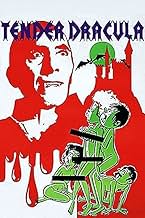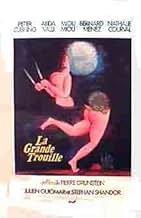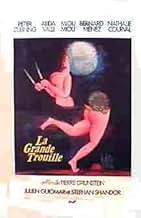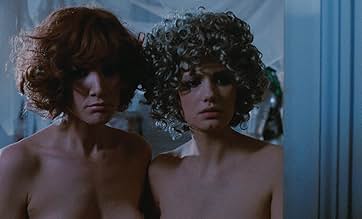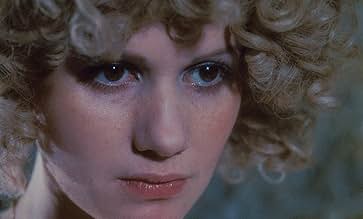Two writers and their girlfriends visit the castle of an actor who specializes in playing vampire roles. As the night progresses, they begin to wonder if the man is an actor playing a vampir... Read allTwo writers and their girlfriends visit the castle of an actor who specializes in playing vampire roles. As the night progresses, they begin to wonder if the man is an actor playing a vampire, or a vampire playing an actor.Two writers and their girlfriends visit the castle of an actor who specializes in playing vampire roles. As the night progresses, they begin to wonder if the man is an actor playing a vampire, or a vampire playing an actor.
Stéphane Shandor
- Boris
- (as Stephane Shandor)
Brigitte Borghese
- La Secrétaire du Producteur
- (as Brigitte de Borghese)
Robert Edwards
- MacGregor - as a Child
- (uncredited)
Featured review
"Tendre Dracula," a 1974 film directed by Pierre Grunstein, is an eccentric attempt to blend horror and comedy, resulting in a curious yet ultimately flawed cinematic experience. The movie stars Peter Cushing as a retired horror film actor who lives in a secluded castle, embodying a peculiar charm that is both endearing and perplexing. Despite the intriguing premise, the execution falls short of its potential, leaving viewers with a mixed bag of amusement and frustration.
Cushing's portrayal of MacGregor, the actor who decides to live as the vampire character he once portrayed, is undoubtedly the film's highlight. His performance is both campy and sincere, providing a semblance of gravitas to an otherwise disjointed narrative. The supporting cast, including Alida Valli and Miou-Miou, deliver performances that range from entertaining to bewildering, adding to the film's uneven tone.
The plot of "Tendre Dracula" meanders through a series of absurd and often nonsensical scenarios. MacGregor invites two scriptwriters to his castle, ostensibly to help him write a new horror film. However, the writers soon find themselves caught in a bizarre game where the lines between fiction and reality blur. The film attempts to explore themes of identity and the nature of fear, but these are undermined by a lack of coherent storytelling and inconsistent pacing.
Visually, the film is a pastiche of Gothic horror and 1970s kitsch. The castle setting is appropriately atmospheric, with its dark corridors and candle-lit rooms providing a fitting backdrop for the film's eerie yet comedic tone. However, the cinematography lacks finesse, often feeling amateurish and failing to fully capitalize on the setting's potential. The special effects are rudimentary, which, while expected for the era, often detract from the film's intended horror elements.
The script is riddled with awkward dialogue and forced humor, leading to a series of moments that are more confusing than comedic. There are instances of clever satire and dark comedy, but these are sporadic and insufficient to sustain the film's intended mood. The humor often feels out of place, disrupting the balance between horror and comedy and resulting in a disjointed viewing experience.
Musically, "Tendre Dracula" features a score that is as erratic as its narrative. The soundtrack oscillates between eerie, suspenseful compositions and quirky, upbeat tunes that clash with the film's darker elements. This further contributes to the film's identity crisis, as it struggles to maintain a consistent tone.
Despite its numerous flaws, "Tendre Dracula" is not without its charms. There is a certain appeal in its audacious attempt to blend genres and its unabashedly quirky style. The film has moments of genuine creativity and offers a unique, albeit flawed, cinematic experience. However, these moments are overshadowed by poor execution and a lack of cohesive vision.
In conclusion, "Tendre Dracula" is a curious artifact of 1970s cinema that, while occasionally entertaining, ultimately fails to deliver on its promising premise. Its blend of horror and comedy is hampered by inconsistent storytelling, uneven performances, and a lack of technical polish. For those intrigued by the eccentricities of vintage horror-comedies, it may hold some appeal, but for most viewers, it is likely to be a disappointing watch.
Cushing's portrayal of MacGregor, the actor who decides to live as the vampire character he once portrayed, is undoubtedly the film's highlight. His performance is both campy and sincere, providing a semblance of gravitas to an otherwise disjointed narrative. The supporting cast, including Alida Valli and Miou-Miou, deliver performances that range from entertaining to bewildering, adding to the film's uneven tone.
The plot of "Tendre Dracula" meanders through a series of absurd and often nonsensical scenarios. MacGregor invites two scriptwriters to his castle, ostensibly to help him write a new horror film. However, the writers soon find themselves caught in a bizarre game where the lines between fiction and reality blur. The film attempts to explore themes of identity and the nature of fear, but these are undermined by a lack of coherent storytelling and inconsistent pacing.
Visually, the film is a pastiche of Gothic horror and 1970s kitsch. The castle setting is appropriately atmospheric, with its dark corridors and candle-lit rooms providing a fitting backdrop for the film's eerie yet comedic tone. However, the cinematography lacks finesse, often feeling amateurish and failing to fully capitalize on the setting's potential. The special effects are rudimentary, which, while expected for the era, often detract from the film's intended horror elements.
The script is riddled with awkward dialogue and forced humor, leading to a series of moments that are more confusing than comedic. There are instances of clever satire and dark comedy, but these are sporadic and insufficient to sustain the film's intended mood. The humor often feels out of place, disrupting the balance between horror and comedy and resulting in a disjointed viewing experience.
Musically, "Tendre Dracula" features a score that is as erratic as its narrative. The soundtrack oscillates between eerie, suspenseful compositions and quirky, upbeat tunes that clash with the film's darker elements. This further contributes to the film's identity crisis, as it struggles to maintain a consistent tone.
Despite its numerous flaws, "Tendre Dracula" is not without its charms. There is a certain appeal in its audacious attempt to blend genres and its unabashedly quirky style. The film has moments of genuine creativity and offers a unique, albeit flawed, cinematic experience. However, these moments are overshadowed by poor execution and a lack of cohesive vision.
In conclusion, "Tendre Dracula" is a curious artifact of 1970s cinema that, while occasionally entertaining, ultimately fails to deliver on its promising premise. Its blend of horror and comedy is hampered by inconsistent storytelling, uneven performances, and a lack of technical polish. For those intrigued by the eccentricities of vintage horror-comedies, it may hold some appeal, but for most viewers, it is likely to be a disappointing watch.
- MajesticMane
- Jun 20, 2024
- Permalink
Storyline
Did you know
- TriviaFor the original French version, L'étudiant de Prague (1935) was dubbed by Jean Rochefort..
- ConnectionsReferences Le météore de la nuit (1953)
- SoundtracksPlay the Devil
Written by Harold Brav, Justin Lenoir, Karl Heinz Schäfer
Performed by Alida Valli, Peter Cushing
- How long is The Big Scare?Powered by Alexa
Details
- Release date
- Country of origin
- Language
- Also known as
- La grande trouille
- Production companies
- See more company credits at IMDbPro
- Runtime1 hour 38 minutes
- Sound mix
Contribute to this page
Suggest an edit or add missing content








